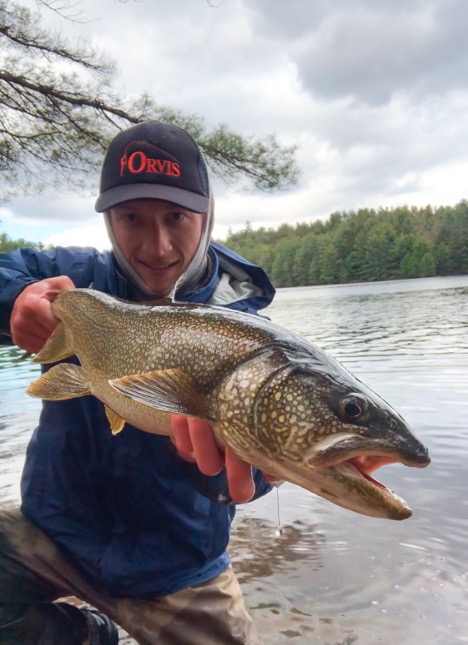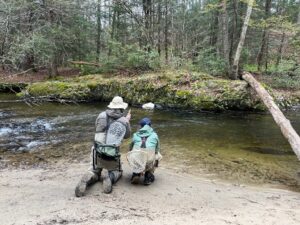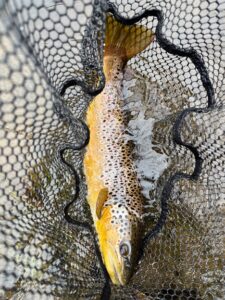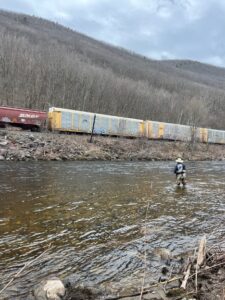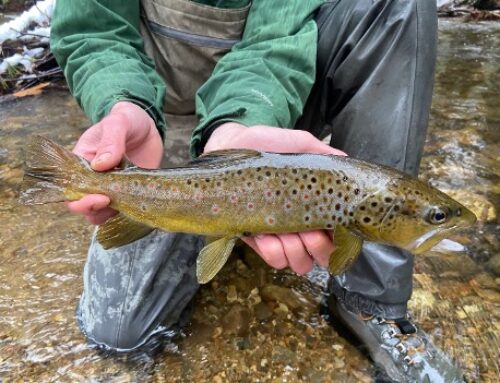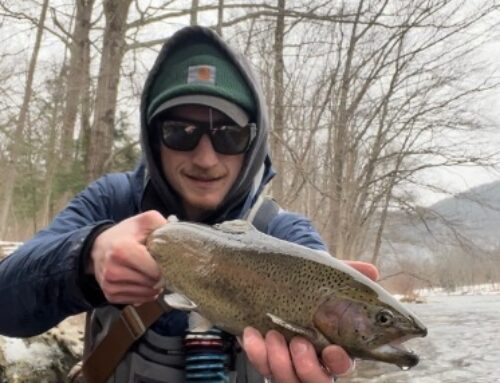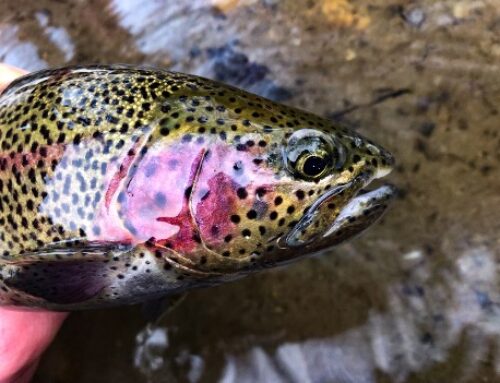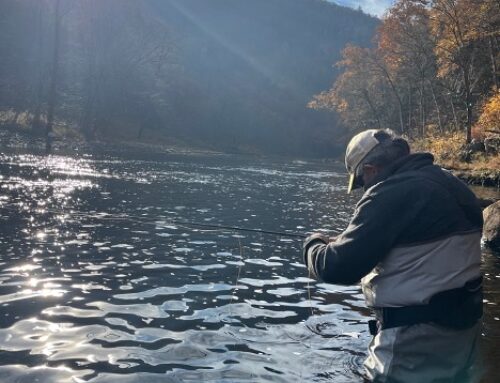Welcome to the season of transition! A lot is changing across the fishery at this time of year as fish pull out of their wintering patterns and begin their spring routines.
On the Fife Brook stretch of the Deerfield, flows had been high owing to a good amount of rain and continued runoff from higher up in the water shed, however, flow forecasts have recently included intervals of low water (130 CFS). It’s likely that we’ve entered the scheduled release period and can expect similar flow conditions going forward, barring a significant rain event. On the stretches below Fife Brook, flows are ranging between 500 and 1100 CFS which is a significant downtrend from the much higher flow we were seeing on the lower stretches earlier. We’ll see if this trend continues.
One of the hot button issues on the Deerfield is the arrival of spring stockies—the D has been stocked amply with rainbow trout in Charlemont, Buckland, Shelburne Falls, Conway, and Deerfield. Typically, newly stocked trout will seek out and group together in the most stable depth near their dropping point, however, consider that the state has completed these stockings in relatively high water which will likely distribute the new fish farther than usual. Check out the Massachusetts trout stocking report for the general areas where they’ve dropped new fish, but don’t be afraid to veer wider away from these points especially as the season progresses.
In terms of approach, a lot of newly stocked fish which have not yet learned to feed naturally will have a go at just about anything that enters their window, so casting small, flashy streamers can often be a fun and productive way to target them. In the event you find a group of less willing fish, an egg pattern thrown on either an indicator or contact rig will usually get the job done. This being said, newly stocked trout must learn to feed naturally quickly and will increasingly turn their attention towards natural forage, so make sure to have a solid representation of nymphal imitations in your box.
In a final word about stocked fish on the Deerfield, be aware that the decision has been made to stop stocking altogether above the Zoar Gap. This choice has been made with the hope of establishing a more robust wild brown trout population in the upper river, and for lack of better phrasing, is a bit controversial. Make sure to reach out with any questions regarding this decision.
Alright, enough about stocked fish for now. This time of year is also marked by significant opportunities to target the Deerfield’s larger wild browns. If you follow the area’s guides and float boaters especially, you’ll notice a stark uptick in captures of upper percentile trout. As water temperatures creep further into the 40s, a lot of these fish have the feed bag on after the meager pickings of winter. Increased forage activity from both bugs and bait drives these fish wild as they begin to pull out of wintering patterns and take up residence in prime lies. In terms of approach, both nymphs and streamers will get the job done. On the “nymphal” side, junk patterns like worms, mops, leeches, eggs and the like often reign supreme as a lot of such forage becomes prevalent during runoff, but make sure to also have a solid representation of stonefly, mayfly, and caddis nymphs in the box as those larvae start to become more active.
As for streamer fishing, play around with size and profile but it’s often a good idea to start out pretty big and size down from there as needed. In the store, we like the alter-ego, hog snare and ice pick (all by Rich Strolis) for a larger option, and are fans of the mini alter-ego, mini avenger and bank robber sculpin when it’s time to size down.
Speaking of, also consider that sculpins—one the river’s top forage for big, wild trout—are spring spawners and will likely begin spawning activities soon if they haven’t already. Sculpin are very bottom-oriented, however, can be flushed out of holds along the riverbed and up into the water column, a feeding opportunity that many big browns keep a keen eye out for. The bank robber is a great option for such an imitation, however, Galloup’s zoo cougar has stood the test of time for imitating this pattern for a reason. Keep in mind that when sculpins get flushed out, they generally bail directly downstream in hopes of reaching the safety of bottom again, so consider that in your approach for both casting and retrieving.
In a final note on the Deerfield and looking a bit ahead, consider that we are not terribly far off from the first major hatches of the year. Blue winged olives have already begun to come off sparsely, especially in the early afternoon with an overcast, low ceiling overhead. Their numbers are currently limited and there’s not many fish rising to them at the moment—especially with the high water—but keep your eyes peeled for risers especially as water temperatures continue to creep up and flows trend down. For imitation, keep in mind that spring BWOs can range widely in size (#18-#24), so make sure to have ample variety in your box. Small parachutes, sparkle duns, CDC emergers and the like are all excellent options for olive imitation.
Looking further ahead, we are not far off from the arrival of both quill Gordon and Hendrickson mayflies, the former of which usually appears after several days of sustained water temps around 50° and the latter around 55°. The prolificity of these hatches varies from year to year but it’s important to have some imitations ready to go in the event you come across a hatch. Keep in mind that both these mayflies are relatively big bugs (size 12 to 14) and are usually best imitated by Adams-style dry flies, however, appropriately sized sparkle duns, parachutes and CDC-winged patterns will get the job done too.
Elsewhere on the Millers River, the story is pretty similar to the Deerfield. Flows are high—running around 800 CFS as this report is being written. The Millers takes a while to drain and with more rain in the forecast, will likely remain relatively high for the immediate future. This being said, the river has been fully stocked in Montague, Erving, Wendell, Orange, and Royalston. Like the Deerfield, the fact that these new fish have been dropped in higher water will likely mean wider and quicker distribution away from the stocking points. The Millers can be very tough to both access and fish during high water, but the same concepts will apply where you’re able to have a go. Small streamers, egg and other junk patterns will be winning tickets especially for the new stockies. Keep in mind that both holdover and natural reproduction rates in the Millers are low so you’re primarily targeting the newly stocked fish. Like the Deerfield, these fish will increasingly turn their attention towards natural forage so make sure to keep your nymph box close by.
On the Westfield River, flows are currently considerably lower than on the D or the Millers, however, expect a bump with any rain in the forecast. The river has mostly been stocked. For now, the same principles we’ve already discussed for new stockies will apply here—see what you can do to move some fish with small streamers and don’t be afraid to turn to an egg or some other juicy junk if you find yourself struggling. Lastly, remember to keep a close eye on water temperatures as the season’s first major hatches approach and the new fish learn to seek out natural forage both below and above the surface.
Below Quabbin on the Swift River, the situation continues to be anything but ideal. Despite recent stockings, the river is notably barren. Of course there are some fish pushed up into the Y-Pool and at the hatchery pipe, however, you’d be pretty hard pressed to find opportunities elsewhere, especially on the upper river. The good news is that they dropped more fish—this time browns—on the 9th so we’ll see if these newbies stick around. As for the reason why the Swift is so empty right now, we don’t have an exact answer for you. We’ve received reports of significant otter activity and poaching (one report even said that someone ran a gill net across the pipe area); whatever the case, something funky is going on below Quabbin. Keep a sharp eye out for poaching and make sure to report it if you do come across someone breaking regulations. Beyond that, if you are able to find some of these new fish on the upper river, you guessed it, small streamers and eggs should probably be the first patterns out of the box.
Numbers aren’t too much better on the lower Swift (Bondsville and Palmer), however, this time of year presents a narrow window of opportunity to target fish, especially wild brookies, rising to BWOs. Olives have been observed coming off in relatively significant numbers, usually in the early afternoon on overcast days with a low cloud ceiling. These hatches have been predominantly occurring in areas of slower water, especially on the margins of the river channel. These olives are averaging around size 18 and are well imitated with appropriately sized patterns like a parachute Adams, sparkle dun, RS2 and other CDC-winged emergers. Beyond that, keep in mind that the lower river was also stocked with both brown and tiger trout on the 9th, so here’s hoping those numbers stick around.
As for local small water, the season of transition is finally upon us. In many creeks across the fishery, wild and holdover trout are pulling out of deeper wintering areas and redistributing across their respective systems. Depending on where you’re fishing, these numbers are also joined by newly stocked fish. Flows in most creeks are up as runoff and spring precipitation continues, but there should be plenty of opportunity to drift nymphs and run small streamers along softer current seams and margins. It’s still a bit early to be thinking about dry flies or dry droppers so these tactics will be your best bet for now, however, we’re likely only a few short weeks away from opportunities at the surface. Once creek trout start looking up, you can reasonably expect solid action on top all the way through September. Whether owing to a lack of pressure, ample forage diversity, or both, creek trout both wild and stocked tend to be pretty willing to have a go at just about anything on the surface that’s properly presented. Your best bet will be to select durable, high floating patterns that can withstand the abuse of lots of eats. In store, we love a stimulator, a PMX, or a good old fashioned elk hair caddis, but you really can’t go wrong for the most part.
Other than trout, it’s important to note upcoming opportunities for pre-spawn smallmouth bass especially in the lower reaches of the Deerfield, Millers and Westfield rivers. Many smallies will traverse up into such areas of Connecticut River tributaries to winter-over and then spawn, presenting a somewhat brief but often fruitful window to target big, pre-spawn bass. Wade access in these spots can be tricky, especially with higher flows, but it’s worth it to do some searching. The actual bass spawn itself is still pretty far off (58-65°F water temperature is the key), however, smallies will grow increasingly active as water temps creep up towards the 50s. These fish are well targeted with streamers like a gamechanger and other baitfish patterns as well as a variety of craw patterns. During the pre-spawn period, smallies will remain pretty bottom-oriented while lingering in deeper water near chosen spawning grounds, so it’ll be a good idea to have a sinking line system of some type to deliver flies down to the appropriate depth. This of course is not a hard and fast rule, and you may find fish willing to feed higher up in the column, so experiment and see what works.
Still water opportunities also pick up significantly around this time of year on big and small water alike. The big reservoirs—Quabbin and Wachusett—re-open in April and present solid opportunities for pre-spawn bass and even lake trout and landlocked salmon. Wachusett is already open and is a little easier to attack with a fly rod as you generally have a greater volume of spots with necessary back-cast space. Both smallies and lakers on the Chu in the early season are known to chase bait into shallow water where they can be targeted with fly gear. Bass and lakers in the Quabbin (opens April 19th) generally don’t come in as shallow as they do on Wachusett but they can still be targeted especially from a boat. Rental boats on the Q can get the job done if you know the reservoir well, but one’s best bet will be to get on something with sonar/graphics. These fish move a lot and it’s big water, so having some sub-surface imaging is usually all but necessary in the process of tracking bait and the predators following it.
Lastly, keep in mind that northern pike have likely entered or are approaching their post-spawn in most places and many of these fish will be on the hunt to get some calories back after spawning. Pike will often hang around their spawning areas in the shallow water of flood plains and marshes as they seek out what is often one of their first decent meals of the spring and as they wait for the cover of aquatic vegetation to grow in.
Off the water, fast approaching is the fourth season of our very popular Women’s Fly Fishing Retreat which will be held on May 2-3. This event is aimed at beginners, but intermediates who want to brush up or reinforce their skills are welcome as well.
On the late afternoon of the first day, Cynthia Harkness of Fearless Fly Fishing, who has more than ten years of experience teaching fly fishing and guiding clients on both fresh and salt water, will cover all the basics of fly fishing. From putting a rod together and rigging it up to selecting a fly and tying it on to casting that bug out there and where to cast it, Cynthia will guide you through the process. She will cover the basic gear and terminology, knots, hands-on casting instruction, fish feeding and behavior, and more over three hours on Friday afternoon/evening. On the second day, we will reconvene in the morning for a half-day float trip in our area waters where our professional guides will get you on the river and help you put into action everything Cynthia went through the day before.
The cost for the Retreat is $375 per person and includes use of all equipment, the Friday seminar with Cynthia Harkness and a half day float trip, guide tip included. In addition, all participants will get 10 percent off anything in the shop and there will be special deals on starter fly fishing equipment packages. Contact brian@deerfieldflyshop.com or call 413-397-3665 to reserve your spot!
As always, thank you for your continued support from all of us at the Deerfield Fly Shop. We wish you luck next time you’re out and hope to see you in the shop soon.


